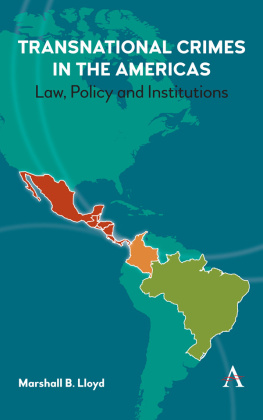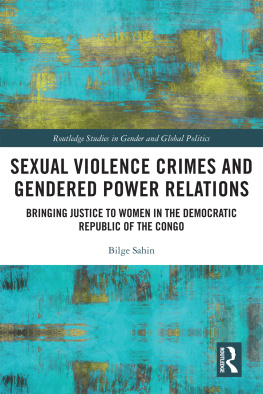SEX CRIMES
Sex Crimes
TRANSNATIONAL PROBLEMS AND GLOBAL PERSPECTIVES
Alissa R. Ackerman and Rich Furman
EDITORS

COLUMBIA UNIVERSITY PRESS NEW YORK
COLUMBIA UNIVERSITY PRESS
Publishers Since 1893
New York Chichester, West Sussex
cup.columbia.edu
Copyright 2015 Columbia University Press
All rights reserved
E-ISBN 978-0-231-53948-7
Library of Congress Cataloging-in-Publication Data
Sex crimes : transnational problems and global perspectives / [edited by] Alissa R. Ackerman and Rich Furman.
pages cm
Includes index.
ISBN 978-0-231-16948-6 (cloth : alk. paper) ISBN 978-0-231-16949-3 (pbk.) ISBN 978-0-231-53948-7 (electronic)
1. Sex crimes. 2. Human trafficking. 3. Transnational crime. I. Ackerman, Alissa. II. Furman, Rich.
HV6556.S423 2015
364.15'3dc23
2014035100
A Columbia University Press E-book.
CUP would be pleased to hear about your reading experience with this e-book at .
Cover design: Noah Arlow
References to websites (URLs) were accurate at the time of writing. Neither the author nor Columbia University Press is responsible for URLs that may have expired or changed since the manuscript was prepared.
CONTENTS
SEXUAL VIOLENCE, PERHAPS MORE THAN any other type of crime, elicits visceral responses from the public. Armed almost exclusively with media accounts of specific sexually violent acts or vague narratives about highly charged topics (e.g., sex trafficking), the public and politicians respond in ways that are somewhat limited or bounded by a lack of understanding about the contexts and experiences of sex crimes that occur every day around the world. While goodwill exists toward finding solutions to combat the various forms of sexual violence, the fact remains that harsh and often ineffective policies are designed and implemented because of a limited understanding about the real nature of sex crimes. This book seeks to fill this gap in knowledge by providing a global and transnational lens through which to view the subject.
Sexual violence is endemic to all parts of the world and frequently transcends national borders. The policies that are enacted to combat crimes of this nature often do not or cannot transcend these same borders. Even within a countrys borders, formal criminal justice policies may not be effective at preventing or decreasing sexual crimes. For example, within national borders, as in the case of poor and developing countries such as Cambodia, criminal justice systems are ill-equipped to handle sex crimes, and outsiders see as illegal the informal tools that are often used. Sexual crimes are significant social problems in all countries, and we can learn a great deal from understanding sex crimes and sex crimes policies across the world.
A recent report found that globally one in fourteen girls and women over the age of 15, or 7.2 percent, will be sexually assaulted in their lifetime (Abrahams et al. 2014). Such statistics quantify what can only be viewed as serious human rights violations; prevention of sexual violence is an essential human rights issue. In addition to these most intense and severe sexual crimes, various types of sexual violence represent a diverse group of sexual offenses.
Sadly, it is the few, most extreme and sensational cases that make the headlines. Far too often victims of every varietychildren, adults, minorities, even animalsare ignored or forgotten while the focus remains on examples picked up, and usually distorted, by the media. Such media representations globally not only lead to erroneous conceptions of the nature of sexual crimes but also prevent a focus on the real lived experiences of many victims. This focus devalues the impacts on and experiences of countless individuals. To truly understand the depth and breadth of sexual violence worldwide and to create lasting and effective prevention measures, we must adopt a global and transnational view of the subject. We must appreciate and understand differences in approaches to combating sexual violence. When programs are effective at inducing positive change, we must learn from them. When programs fail to help survivors achieve justice and balance in their lives, we must know how to make adjustments to those programs. This book seeks to fundamentally expand the way we view sexual violence and the policies and practices aimed at reducing it.
Readers might ask, what is the importance of understanding sex crimes from a transnational and global perspective? Is it not enough to understand the nature of sexual crimes in ones own cultural context? Are the policies and practices of other countries not so different that they are irrelevant to, for example, the context of the United States? The answers to these questions help frame the rationale for this book and will help the reader place the diversity of perspectives and vantage points in context. In the following paragraphs, we explore how and why sexual crimes must be understood from a global and transnational perspective.
First, in the new millennium, no social problem exists outside of the context of globalization. Sex crimes, in spite of stereotypes about the nature of defective, sociopathic perpetrators, are not merely crimes committed by the sick and deranged; they occur within the context of social and economic upheavals that affect whole communities. Poverty, alienation, and lack of community integration and support services, for example, all influence rates of recidivism for sexual crimes. As the forces of globalization affect the economic viability of communities and have a disproportionate impact on marginalized communities in the United States and throughout the world, various social stressors serve as a context within which sexual offenses occur. Sex offender policies, as with other social policies, are bound to fail if they do not account for the full scope of social forces that contribute to the creation of the problem. Ameliorating the conditions that exacerbate sexual crimes in communities demands that policy practitioners of the future view the interconnectedness of social problems on macro, even global scales. In this sense, globalization represents an important conceptual lens for those interested in sex crime amelioration and policy.








![Reichel - Global Crime: an Encyclopedia of Cyber Theft, Weapons Sales, and Other Illegal Activities [2 Volumes]](/uploads/posts/book/262750/thumbs/reichel-global-crime-an-encyclopedia-of-cyber.jpg)


 COLUMBIA UNIVERSITY PRESS NEW YORK
COLUMBIA UNIVERSITY PRESS NEW YORK
